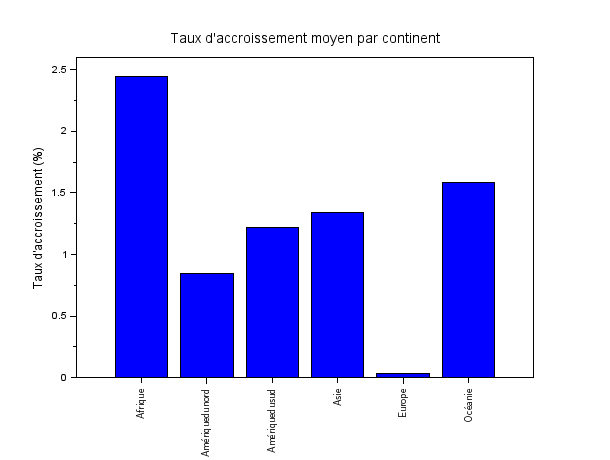Exercice 3 : Taux d'accoissement naturel
On rappelle que le taux d’accroissement naturel est la différence entre la natalité et la mortalité.
Table des matières
- Acroissements minimaux et maximaux
- Pays ayant un taux d'accroissement négatif
- Moyenne
- Moyenne par continent
- Estimation de la population mondiale en 2050
Question 1 : Acroissements minimaux et maximaux
Quels sont les accroissements minimaux et maximaux ?
tauxAccroissement = (data(:, 4) / 1000) - (data(:, 5) / 1000);
tauxAccroissementMin = min(tauxAccroissement)
tauxAccroissementMax = max(tauxAccroissement)
Résultat :
- Taux d'accroissement minimal : -0.60%
- Taux d'accroissement maximal : 3.80%
Question 2 : Pays ayant un taux d'accroissement négatif
Faire afficher la liste des pays pour lesquels l’accroissement est négatif.
pays(tauxAccroissement < 0)
Résultat :
Pays ayant un taux d'accroissement négatif :
- Japon : -0.20%
- Estonie : -0.10%
- Lettonie : -0.30%
- Lituanie : -0.30%
- Allemagne : -0.20%
- Biélorussie : -0.10%
- Bulgarie : -0.60%
- Hongrie : -0.30%
- Roumanie : -0.30%
- Ukraine : -0.50%
- Bosnie-Herzégovine : -0.20%
- Croatie : -0.30%
- Grèce : -0.30%
- Italie : -0.20%
- Portugal : -0.30%
- Serbie : -0.50%
Question 3 : Moyenne
Déterminer l’accroissement mondial moyen.
mean(tauxAccroissement);
Résultat :
- Taux d'accroissement moyen : 1.32%
Question 4 : Moyenne par continent
Faire un graphe de l'accroissement moyen suivant le continent.
tauxAccroissementMoyenParContient = [mean(tauxAccroissement(1:57)), mean(tauxAccroissement(58:86)), mean(tauxAccroissement(87:99)), mean(tauxAccroissement(100:150)), mean(tauxAccroissement(151:193)), mean(tauxAccroissement(194:207))];
bar(tauxAccroissementMoyenParContient * 100)
Résultat :
Question 5 : Estimation de la population mondiale en 2050
Quelle est la population mondiale prévue en 2050 ? Cela est-il conforme à l’hypothèse d’un taux d’accroissement constant ? Justifier.
population2050 = sum(data(:, 6)*1000000)
x = population;
while population2050 > x
x = x * (1+tauxAccroissementMoyen);
end
Résultat :
- La population mondiale prévue en 2050 est de 9 848 330 000 habitants.
- La population mondiale prévue en 2050 n'est pas conforme à l'hypothèse d'un taux d'accroissement constant car en multipliant la population mondiale actuelle (7 534 720 000) par le taux d'accroissement moyen (1.32%) jusqu'à atteindre ou dépasser la population mondiale prévue en 2050 (9 848 330 000), on obtient une prévision largement supérieur à la population mondiale prévue en 2050 (+ 67 843 751).
